Italian Citrus Fruits: Prospects for the Season Edition 4. 20 24
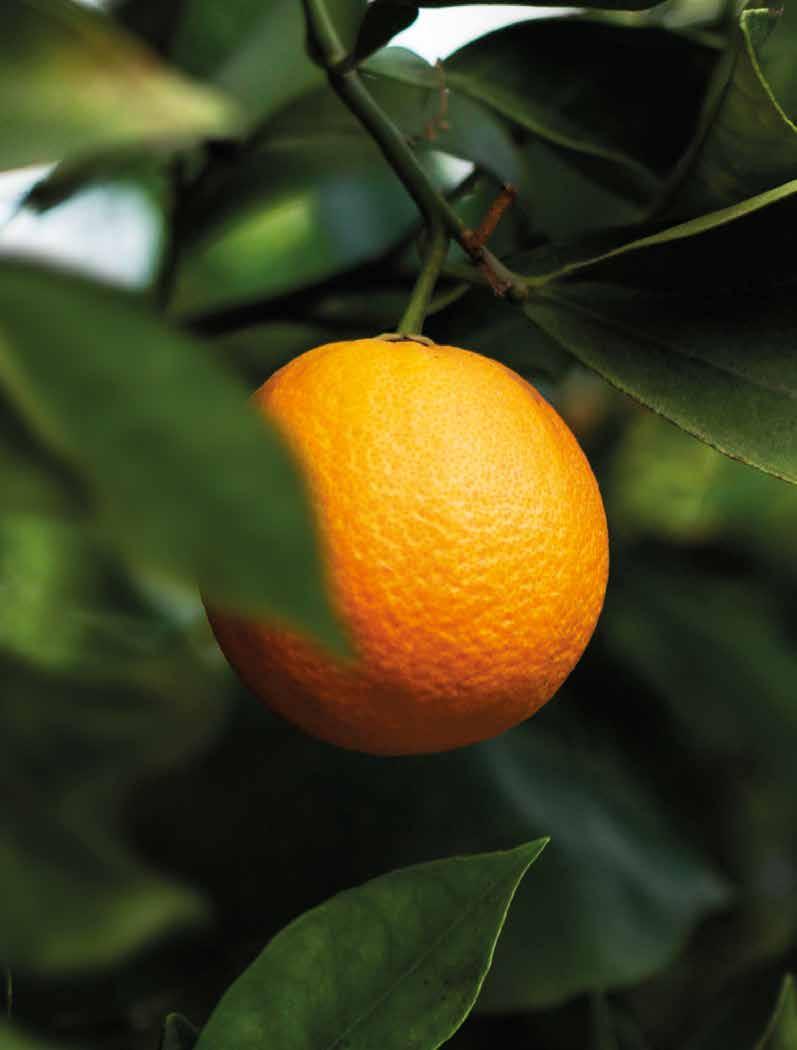
2 Citrus Report 2024
Contents
Pag. 5
Pag. 6
Pag. 6
Pag. 9
A new year. Challenges and prospects.
By Paolo Chirico, General Manager Agrumaria Reggina.
Academic and scientific inputs
Application of the microencapsulated antioxidant bergamot in liquid food systems.
By Antonio Gattuso and Marco Poiana, Mediterranean University of Reggio Calabria, Department of Agriculture, Food Technology Unit.
The collaboration between Agrumaria Reggina and the University of Messina to determine the authenticity and quality of citrus fruit essential oils. By Paola Dugo, University of Messina, Department of Chemical, Biological, Pharmaceutical and Environmental Sciences.
Pag. 10
Pag. 14
Pag. 14
Pag. 15
Pag. 16
Pag. 17
Pag. 18
Pag. 18
Pag. 22
Pag. 24
Pag. 26
Pag. 27
Pag. 28
Pag. 29
Pag. 30
Pag. 31
Pag. 33
Pag. 34
A story about lemon juice. By Mikko Hofsommer, CEO of GfL Berlin.
The citrus fruit season: data, analyses and prospects
General production overview
Analysis of total citrus fruit production (2021-2023)
Analysis of the cultivated area of citrus fruits (2021-2023)
Analysis of Citrus for Processing (2021-2023)
Conclusion on statistical analysis
Forecast for the 2024 season: citrus fruits production analysis
The phytosanitary conditions of citrus fruits
By Salvatore Lauria, Agronomist and Citrus Fruit Expert.
Telling about farms: stories of passion and sustainability
Azienda Agricola Valleverde
Azienda Agricola La Favorita
Azienda Agricola Mazzitelli
Azienda Agricola Surace
Azienda Agricola Franco Palumbo
Azienda Agricola Merlino Antonino
Agrumaria Reggina’s role in the next citrus season
By Felice Chirico, Sales & Marketing Director Agrumaria Reggina.
About Agrumaria Reggina
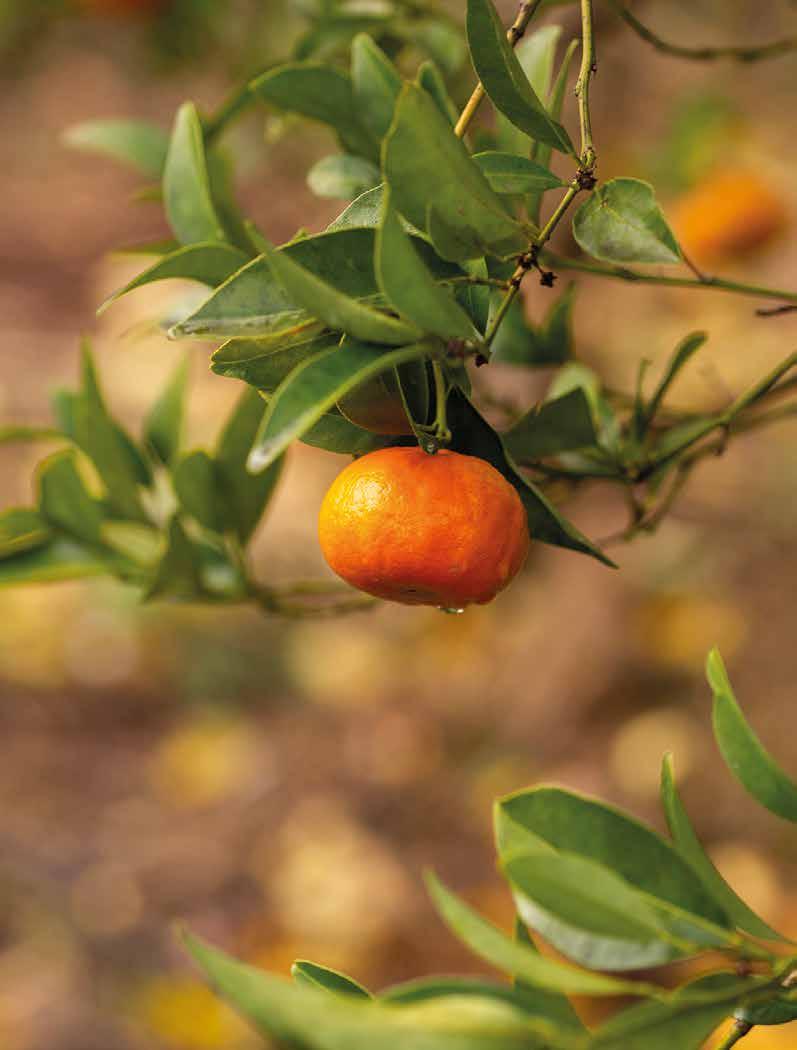
Climate change is one of the most significant challenges affecting the citrus fruit industry “
4 Citrus Report 2024
A new year Challenges and prospects
By Paolo Chirico, General Manager Agrumaria Reggina.
Dear readers,
we are excited to present the fourth edition of our annual report on the Italian citrus season. This year, the international context is characterised by strong global instability and unstable foreign supply markets, but at the same time, we are witnessing the growing importance of the Italian citrus supply chain worldwide. We face these challenges with determination, as we recognise the unique opportunities arising for the processing industry as well as for Agrumaria Reggina.
The increasingly unpredictable climate and extreme weather phenomena are affecting the production and quality of citrus fruits. It is necessary to keep investing in projects and resources to make farms more sustainable and able to cope with these climate challenges. Sustainability is the pillar underlying our corporate mission, and we are committed to promoting innovative agricultural practices and reducing the environmental impact of our business.
The report ‘Italian Citrus Fruits: Prospects for the 2024 Season’, provides a statistical and forecasting analysis of the Italian citrus fruit season. The results from the past season as well as the projections for the current one give a comprehensive view of the sector, including production volumes and geographical distribution.
A further section deals with the analysis of the phytosanitary conditions of citrus fruits, edited by Dr. Agronomist Salvatore Lauria. Thanks to his scientific and academic expertise, we are provided with an in-depth look at the phytosanitary challenges that can affect citrus production. This analysis is crucial for developing disease prevention and management strategies for citrus crops.
This edition of the report is enhanced by several scientific and academic contributions, which explore topics related to sustainability, new technologies for growing citrus fruits, and the future prospects of the processing industry. I would therefore like to thank Prof. Marco Poiana of the Department of Agriculture of the Mediterranean University of Reggio Calabria, Prof. Paola Dugo of the Department of Chemical Science of the University of Messina, and Dr. Mikko Hofsommer, CEO of GfL Berlin.
We also want to give a voice to the key players of the citrus fruit industry: the farmers. We collected stories-interviews from some Italian farmers who are passionately and devotedly committed to the production of the citrus fruits that we turn into unique and effective ingredients every day. These stories show the passion and hard work behind each fruit, and inspiring us to continue supporting the Italian farming community.
Lastly, we would like to thank all those who contributed to the production of this report, from the agricultural industry to sector experts and our business partners. Only through transparent collaboration and a common commitment we can build a sustainable future for the Italian citrus sector.
We hope you will enjoy the reading of the report ‘Italian Citrus Fruit: Prospects for the 2024 season’ and that it will be a source of inspiration and valuable information for all of you.
Best regards,
General Manager
5 A new year
“
Academic and Scientific Contributions
In this section, we invited three leading academics and scientists to share their knowledge and expertise with our readers.
Prof. Marco Poiana, Full Professor at the Department of Agriculture of the Mediterranean University of Reggio Calabria, shares an important study on the application of the
microencapsulated antioxidant bergamot in liquid food systems.
Prof. Paola Dugo, from the University of Messina, a leading expert in academic and scientific circles, presents some recent research on citrus essential oils. Finally, Dr. Mikko Hofsommer, CEO of the GfL Berlin analysis laboratory, tells us about a
personal experience with lemon juice. The contributions of these experts provide valuable information for companies in this sector as well as for all those interested in this important economic segment.
Application of the microencapsulated antioxidant bergamot in liquid food systems.
By Antonio Gattuso and Marco Poiana1, Mediterranean University of Reggio Calabria, Department of Agriculture, Food Technology Unit
Scientific studies revealed that the Mediterranean diet, mainly related to the consumption of antioxidant components contained in food, results in a lower risk of developing age-related vascular diseases and increased longevity. Citrus fruits are among the food with a high content of antioxidant compounds, with particular reference to flavonoids. One of the most important citrus fruits cultivated in Reggio Calabria is bergamot, which is a valuable source of active molecules that contribute to its antioxidant, anti-inflammatory and cholesterol-lowering features. Bergamots and their by-product, also called ‘pastazzo’ (i.e. waste resulting from squeezing citrus fruits), raised great interest in the scientific community because of their beneficial effects on human health. The pastazzo is a valuable source of bio-active molecules with a distinctive bitter taste, containing
mainly neohesperidin, naringin and neoeriocitrin flavanones and small amounts of flavones and furanocoumarins. Flavonoids have been shown to have various health properties, particularly related to their antioxidant components. In particular, in recent years, some studies focused on the bergamot flavonoids, because of their relevant properties, such as protection against certain types of cardiovascular diseases. For example, neohesperidin and neoeriocitrin have effective properties in the treatment of osteoporosis, while naringin has anti-inflammatory and anticancer characteristics. In addition, bergamot is a natural source of vitamins A, C and B, sugars, pectin, fibre and other substances with biological properties. Although the by-product of bergamot processing is industrial waste, it is at the same time very rich in antioxidant
compounds that could later be reused as natural additives in the food industry.

1Marco Poiana:
https://www.unirc.it/scheda_persona.php?id=50382
6 Citrus Report 2024
Furthermore, in recent years consumer demand for healthier food increased. The food industry is constantly searching for healthy, beneficial and natural products. Therefore, the need to produce food is no longer just related to the satisfaction of the primal urge of hunger and the provision of the nutrients needed to survive, but it is about promoting health by improving physical and mental well-being and preventing neurodegenerative and cardiovascular diseases, diabetes and cancer. In addition, the world’s exponentially growing population gives rise to a high demand of food and energy to meet its needs. As a result, there was a significant increase in the number of food industries, with an increase in the generation of food waste and the need to both prevent and manage it. It is clear
that the food industry had to deal with changes in society and thus in production and processing, with an impact on the entire food chain leading to a greater attention in the formulation of products meeting the consumers’ needs for a healthy lifestyle.
Industry innovations include the production of new food ingredients and materials, new process technologies, innovations in quality or new packaging methods. However, research focused on the possibility of adding natural ingredients to food that can bring health benefits. These natural ingredients are free from potentially harmful synthetic additives, making way for bioactive natural products that are considered safe substitutes for a market seeking new products. In this respect, functional food stands out as a
compromise between nutrition, health and the environment. They combine nutritional and functional properties with sustainability through the possibility of using active ingredients recovered from agrifood by-products for enrichment or fortification of new food. Natural phenolic compounds such as polyphenols are particularly relevant in this regards, as they are commonly extracted from plant matrices and agrifood waste and used in food production. Their microencapsulation allows protection from external environmental agents, e.g. exposure to light, alkaline environment, high temperatures.

Protection is given by a coating capsule acting as a barrier due to the non-covalent/covalent bonding of polyphenols with biopolymers, resulting in improved stability, bioavailability and antioxidant activity of the active ingredient in question. The use of microencapsulated biological compounds is of scientific and industrial interest, and their functionality was proven by several studies confirming the use of microencapsulated bioactive compounds as an ingredient in the formulation of new food products. Therefore, the exploitation of the natural extract through its use as a new natural ingredient is also ethical due to its high added value when recovered from agrifood waste. This type of application
would lead to a reduction in environmental impact, ensuring the optimisation of natural resources and the improvement of food products.
A research group at the Mediterranean University of Reggio Calabria enhanced the by-product of bergamot by extracting antioxidant compounds to be used as an ingredient in food systems. The extraction was performed by macerating the pastazzo in a hydro-alcoholic mixture. The liquid extract obtained was microencapsulated using maltodextrin as a coating agent with the aim of obtaining a chemically and microbiologically stable powder with the benefits of the microencapsulated product.
The microencapsulated extract was used to enrich an apple juice and sunflower oil at a concentration of 2% (w/w) (Fig. 1).


7 Academic and Scientific Contributions
The enriched products were assessed in their physical-chemical characteristics (colour, pH, °Brix), their antioxidant activity (phenolic compounds and total flavonoids; ABTS and DPPH assays) and their phenolic profile (UHPLCDAD). The main properties of the enriched apple juice and sunflower oil were assessed during storage at 25°C for 90 days. For sunflower oil, also oxidative stability was evaluated.
The results of the enriched
days, and then decreased. The microencapsulated of the apple juice and sunflower oil behaved differently due to the hydrophilic nature of maltodextrin, which is more likely to interact with water instead of oil.
The enriched sunflower oil showed better oxidation resistance than the unenriched sample. Oxidation control is a parameter that defines the quality of edible oils and safety for human health. It depends on several intrinsic and
OXITEST device and expressed as induction period (IP). The IP is considered as the time required to reach the oxidation starting point. As expected, the presence of phenolic compounds added with the microencapsulated resulted in a significant increase in the IP after 45 days at a storage temperature of 25°C, reaching 14:12 (h:m) from 13:16 (h:m) resulting in an improvement due to the antioxidant effect of the bioactive compounds. After 90



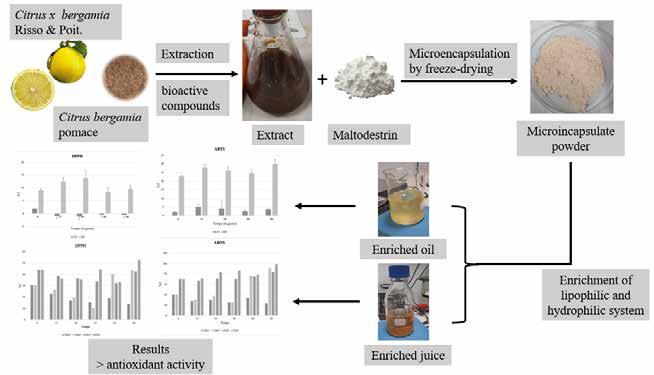
The chemical composition of the bergamot pulp extract (pastazzo) showed that it can be a good source of polyphenols and the positive results obtained highlighted the possibility of enhancing a by-product of the citrus industry by converting it from waste to a resource through the extraction of bioactive compounds. Microencapsulation of the extract was useful to preserve its characteristics and was used in hydrophilic and lipophilic systems to endow them with functional and nutraceutical properties. In particular, microencapsulation with 20 % maltodextrin preserved
a high polyphenol content, excellent antioxidant activity and great microencapsulation performance. The addition of the microencapsulated element enabled a vegetable oil and juice to be enriched, increasing the polyphenol content and antioxidant properties for up to 90 days of storage. The temperaturecontrolled 25°C test carried out on the enriched oil showed good stability over time as evidenced by the results of the oxidative stability analysis. Furthermore, the different release of phenolic compounds in the two products was pointed out, fulfilling the intended function,
i.e. the preservation of antioxidant properties.
Enrichment with microencapsulated powder showed the desired results, with a significant improvement in the antioxidant properties of the two food systems compared to the unenriched samples. This experiment can be considered a good result in terms of functionalisation of oil and beverages with microencapsulated natural ingredients derived from citrus industry by-products.
By Paola Dugo2, University of Messina, Department of Chemical, Biological, Pharmaceutical and Environmental
Since 2023, Agrumaria Reggina has been collaborating with the University of Messina. Specifically, the research activity is carried out in collaboration with the analytical chemistry and food chemistry laboratories (MeIT) of the University of Messina, coordinated by Professors Luigi Mondello and Paola Dugo. The collaboration with the MeIT laboratories is focused on the determination of the authenticity and quality of citrus fruit essential oils. To tackle this task, both the volatile and nonvolatile fractions of cold-pressed citrus essential oils must be studied. The non-volatile fraction of cold-pressed citrus essential oils, which accounts for 2-10% of the total oil, contains about 10-20% heterocyclic oxygen compounds, including coumarins, furocoumarins and polymethoxyflavones. Polymethoxyflavones have numerous beneficial properties for human health, coumarins and furocoumarins were showed to have many positive
2About Paola Dugo:
http://archivio.unime.it/it/paola-dugo/curriculum
biological activities, while ingestion of large quantities of coumarins could pose a risk. On the other hand, furocoumarins show strong photosensitive activity in combination with UV radiation. For this reason, the International Fragrance Association (IFRA) and the European Parliament recently issued opinions and regulations on the use of essential oils in cosmetic products. The use of cold-pressed citrus essential oils as an ingredient in cosmetic products must be monitored to reduce negative effects on skin health. The qualitative and quantitative study of heterocyclic oxygen compounds (together with the volatile fraction) can provide information on safety and authenticity and can be related to different extraction technologies, geographical origin and seasonal variation of cold-pressed citrus essential oils. Although the qualitative composition of some citrus essential oils may be very similar, the target components in heterocyclic oxygen compounds can diversify each essential oil. The amount of coumarins, furocoumarins and polymethoxyflavones in citrus essential oils can vary according to several aspects.
Citrus variety, geographical origin, time of the production season and extraction technology affect the chemical composition of the non-volatile fraction. Therefore, a reliable analytical technique to unambiguously clarify a qualitative and quantitative profile of coumarins, furocoumarins and polymethoxyflavones in coldpressed citrus essential oils should be developed. The aim of this collaboration is to develop analytical techniques using conventional and/ or innovative chromatographic equipment. These analytical methodologies provide useful information both for everyday quality control analysis and for the investigation of molecules contained both in traces of citrus essential oils, food and cosmetic products containing citrus derivatives.
9
The collaboration between Agrumaria Reggina and the University of Messina to determine the authenticity and quality of citrus fruit essential oils.
Academic and Scientific Contributions
Sciences.
A story about lemon juice. About Mikko Hofsommer3, CEO of GfL Berlin
My name is Mikko Hofsommer and this is my citrus fruit story of the year. A few months ago I was approached by a customer. The US authorities had accused him of adding citric acid to his lemon juice. He was desperately looking for help because he was confident of his product.
Reviewing the 59 pages of the report, I came to two conclusions:
1. The charge was based on a high citric acid to isocitric acid ratio, 230 to be accurate. The 13C isotopes were in line with expectations.
2. For the isocitric acid test method, the report cited an enzyme test kit from a supplier.
No mention was made to the IFU Method No. 54, which is considered the reference method as well as the basis for the typical maximum 200 ratio as stated in the AIJN Code of Practice.
This was the analytical wake-up call for me.
Chemical-scientific premise: isocitric acid forms a ‘ring’ (a so-called lactone) over time. Therefore, the concentration decreases more and more during storage. Then, the IFU method provides for a saponification step. This will cause the ring to break and the isocitric acid to return to its original state, then the total isocitric acid is measured.
Guess what I found out by looking at the test kit manual? None of this!
The kit only measures ‘free’ isocitric acid. There is only a small note stating that this sample preparation step, as described above, could be performed! Needless to say, a lower isocitric acid content leads to a high ratio and thus an unjustified charge.
End of story, the goods were released, the supplier of the test kit apologised and harmonised its kit with the protocol, and we at GfL now work for the FDA.
Moral of the story: relevant reference methods were used to establish the AIJN guideline. These are typically the IFU methods. You cannot use just any method and expect the same results.

He serves as the Managing Director of the Analysis Lab Compay Gfl and holds the position of Chairman for the International Fruit and Vegetable Juice Association (IFU) Analytical Methods Committee. Additionally, he is an active member of the AIJN Code of Practice Expert Group.
10 Citrus Report 2024
3About Mikko Hofsommer:

11 Academic and Scientific Contributions
Our Journey for a Sustainable Future

We proudly announce the beginning of our journey with NATIVA, a renowned Regenerative Design Company, to foster a sustainable future for our operations and broader community. This collaboration will enable Agrumaria Reggina to comprehensively evaluate and assess the current impact of the company on all its stakeholders, covering the areas Governance, Workers, Community, Supply Chain,
Environment and Customers, with actions related to several scopes, such as CO2 emissions, sustainable farming practices, energy efficiency, and social responsibility.

The citrus fruit season:
Data, analyses and prospects.
The world of farming, especially in countries like Italy with a strong tradition in this sector, represents an essential component of the economy and culture of the area. This study aims to analyse the trends in citrus fruit production in Italy, based on accurate and up-todate data provided by ISTAT, the National Institute of Statistics. This information was extracted from the ‘Woody fruit crops’
section of the ISTAT portal (http://dati.istat.it/), thus making the report a reliable source for understanding recent trends in this field. Through the analysis, we will focus not only on total citrus fruit production in the years 2021, 2022 and 2023, but we will also explore the cultivated area, highlighting any changes in productivity. In addition to this, we will analyse the percentage of production destined for industrial
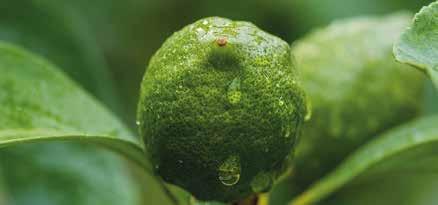
General production overview
The table below provides data on citrus fruit production:
Table 1 Citrus fruit production
processing, providing a full overview of the whole citrus fruit production cycle. Each section will highlight trends, significant variations and particular observations, providing a detailed overview and guidance for future decisions in the citrus fruit farming sector.
Among the different crops, citrus fruits have a prominent position, not only due to their commercial value but also to their relevance in the Mediterranean diet.
14 Citrus Report 2024
Source ISTAT ISTAT ISTAT Blonde Oranges Blood Oranges Mandarins Clementines Lemons Limes Grapefruits Bergamots Citrons Chinotto Other citrus 516.837 150.618 675.883 472.747 600 5.470 27.000 1.150 54 4.413 517.836 156.893 656.840 482.293 600 5.470 27.000 1.150 54 6.771 709.876 154.787 674.349 511.976 600 5.634 27.810 1.150 54 6.854 1.276.631 1.298.700 1.317.442 Production 2021 2022 2023
“
Citrus fruit production in Italy is a key component of national agriculture. Citrus fruits, with
Let us take a closer look at the production trends of some of the main citrus fruits in the years 2021, 2022 and 2023.
their diversity and versatility, not only enrich the Mediterranean diet, but also play a key role in the
economy, exports and agrifood processing.
The analysis of citrus fruit production in Italy shows a positive trend in most categories. This reveals not only the vitality of the citrus sector, but also the importance of these fruits in the Italian culture and economy.
1 2 3 4
Oranges, divided into blonde and blood oranges, represent a significant share of the total citrus fruit production. During the period under review, Blonde Oranges showed a steady growth from 1,276,631 tonnes in 2021 to 1,317,442 tonnes in 2023. Also Blood Oranges were subject to a substantial increase, particularly between 2022 and 2023, with production rising from 517,836 tonnes to 709,876 tonnes.
Although these citrus fruits have lower production volumes than oranges, they maintain a stable presence in the agricultural landscape. Mandarin showed slight fluctuations in production, peaking in 2022 at 156,893 tonnes. On the other hand, a slight decrease was recorded as regards clementines in 2022, but production grew again in 2023, reaching 674,349 tonnes.
Lemons, thanks to their utmost relevance in the Italian diet and cuisine, recorded an increasing production, rising from 472,747 tonnes in 2021 to 511,976 tonnes in 2023. Limes, although produced in much smaller quantities, maintained a stable production, with only a slight increase in 2023.
Bergamot, Citron and Chinotto, in spite of their smaller production volumes, represent the diversity and richness of the Italian citrus landscape. For example, Bergamot experienced a 3 % growth between 2022 and 2023, reaching 27,810 tonnes.
Analysis
The Italian agricultural landscape has always paid special attention to citrus fruit production as a key sector that has a significant impact on the national economy.
The table below summarises the total production in the years referred to above:
Table 2
Total citrus fruit production
Source ISTAT
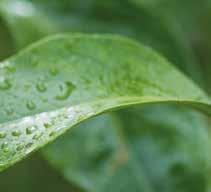
15 The citrus fruit season
2021 2022 2023 3.153.606 3.410.533 3.131.403 Year Total production (tonnes)
of total citrus fruit production (2021-2023)
Blonde and Blood Oranges
Mandarin and Clementines
Lemons and Limes
Bergamot and other citrus
This data shows a sustained growth in citrus fruit production. Between 2021 and 2022, production slightly increased from 3,131,403 tonnes to 3,153,606 tonnes.a HowToever, it is in 2023 that a significant leap is observed, with production reaching
3,410,533 tonnes, recording an increase of more than 250,000 tonnes over the previous year. In conclusion, the positive trend in total citrus production points out the robustness and resilience of the Italian citrus sector, but also stresses the importance of
Analysis of the cultivated area of citrus fruits (2021-2023)
sustainable and careful strategies to maintain and potentially further increase this growth in the coming years.
This data leads to some of the following considerations.
Blonde Oranges: The area dedicated to blonde oranges increased in 2022, but slightly decreased in 2023. This might suggest a readjustment of resources or a crop rotation.
Blood Orange: The cultivated area was stable between 2021 and 2022, with a slight decrease in 2023.
Mandarin and Clementines: Both of these citrus fruits recorded an increase in the cultivated area year after year, pointing out a growing interest in their production.
Lemons: The area dedicated to lemons shown a steady growth, probably reflecting the stable demand and importance of this citrus fruit in the Italian landscape.
Cultivated area is a key indicator for understanding the distribution of land resources dedicated to citrus production. The analysis of this parameter provides information on the degree of investment in the citrus sector and any changes in agricultural priorities.
The cultivated area can vary from year to year due to different factors, such as farming decisions based on market forecasts, climatic conditions, plant diseases or agricultural policies.
16 Citrus Report 2024
Blood
Mandarins Clementines Lemons Limes Grapefruits Bergamots Citrons Chinotto Other citrus 28.902 8.597 25.696 26.034 30 301 1.500 65 6 175 28.902 8.786 26.188 26.211 30 301 1.500 65 6 281 28.652 8.866 26.763 26.567 32 301 1.500 65 6 305 55.895 56.570 55.315
Table 3 Cultivated area Source ISTAT ISTAT ISTAT Blonde Oranges
Oranges
Cultivated area (hectares) 2021 2022 2023
The table below shows the percentage growth in cultivated area for each citrus fruit between 2021 and 2022, and between 2022 and 2023: Table
In conclusion, the cultivated area provides interesting insights into the evolution of the citrus sector. Increases in some categories suggest a response to market needs, while decreases may reflect agronomic challenges or strategic farm decisions.
The citrus processing sector is a key element of the citrus fruit production chain. Citrus fruits for processing are used to produce a wide range of products, including juices, essential oils and many other consumer products. The analysis of this component enables
to understand the share of total production directed towards industry, providing insights into market trends and consumer preferences.
The percentage of citrus fruit intended for processing varies according to the type of fruit and
the specific market needs. Almost the entirety of the production of some citrus fruits, such as Bergamot and Chinotto, is directed towards industry, given their specificity and prevalent use in processed products.
The table below shows the percentage of citrus fruit intended for processing and the percentage growth of the quantity processed between 2021 and 2022, and between 2022 and 2023: Table 5
4 Statistical percentage of the quantity of fruit produced destined for the processing
17
Quantity
destined for
Source ISTAT ISTAT Blonde Oranges Blood Oranges Mandarins Clementines Lemons Limes Grapefruits Bergamots Citrons Chinotto Other citrus 0,0% 2,2% 1,9% 0,7% 0,0% 0,0% 0,0% 0,0% 0,0% 60,6% -0,9% -0,9% 2,2% 1,4% 6,7% 0,0% 0,0% 0,0% 0,0% 8,5% 1,2% -2,2% Change in cultivated area 2022 vs 2021 2023 vs 2021 Source Blonde Oranges Blood Oranges Mandarins Clementines Lemons Limes Grapefruits Bergamots Citrons Chinotto Fruit 283.950 38.697 134.870 179.192 60 563 27.532 460 53 526.977 2023 207.135 39.223 131.368 168.802 60 547 26.730 460 53 519.480 2022 206.735 37.655 135.177 165.461 60 547 26.730 460 53 510.653 2021 40% 25% 20% 35% 10% 10% 99% 40% 99% 40% % processed4
of citrus fruit
processing
4 Change in
area Analysis of Citrus for Processing (2021-2023)
cultivated
The citrus fruit season
industry
Some observations:
1. Blonde Oranges
With a stable 40% for processing, Blonde Oranges show an extreme increase in terms of tonnes destined for the industry. This suggests that, despite increasing production, demand for blonde oranges is still strong, while the processing industry benefits from the increase in overall production.
2. Blood Oranges
Although the percentage destined for processing is stable at 40 %, it is interesting to note a considerable stride between 2022 and 2023, with an increase of more than 76,000 tonnes. This means an increasing demand for blood orange products, especially juices (natural and concentrated).
Conclusion on statistical analysis
The in-depth analysis of the data on production, cultivated area and quantity of citrus fruit for processing in the years 2021, 2022 and 2023 provides a clear view of the development of the citrus fruit sector in Italy. There are clear signs of a healthy and growing sector. The overall production shows a positive trend, with a substantial increase in 2023, highlighting a constant demand and an effective response from producers.
3. Lemons
The 35% share of lemons for processing is constant, but the absolute quantity recorded a growth year after year. This reflects the importance of lemons not only as table fruit, but also for the production of byproducts.
The cultivated area, while showing some variations between different types of citrus fruits, indicates a continuous and sustained commitment to the cultivation of these precious fruits. Furthermore, the significant percentage of citrus fruits destined for processing points out the versatility of the Italian citrus fruits and their relevance in a wide range of consumer and industrial products. In summary, the Italian citrus sector
4.Bergamot and Chinotto
These two citrus fruits, with a processing percentage close to 99%, are mainly destined for industry. Bergamot, for example, is essential in the production of perfumes and flavourings, while Chinotto is mainly used for drinks and syrups. Their production, although in smaller volumes than other citrus fruits, has a significant impact in specific industrial sectors.
shows remarkable robustness and resilience, confirming its leading position in the European and global agricultural framework. These data, together with the trends observed, boost confidence in the importance of citrus fruits in the Italian culture, economy and diet, and highlight the importance of continuous innovation and investment to maintain and further enhance this growth.
The agricultural sector, being closely linked to climatic and environmental conditions, is always subject to uncertainties. While citrus fruit production in past years shown a positive trend, it is essential to consider different factors that could influence future production.
Based on data provided by ISTAT and other statistical forecasts, here is an overview of forecasts for 2024 compared to production in 2023:
Table 6 Citrus fruits production forecast for season 2024
18 Citrus Report 2024
Forecast for the 2024 season: citrus fruits production analysis 496.913 123.830 922.209 Source ISTAT Statistical forecast Blonde Oranges Blood Oranges Mandarin 709.87 154 1.317.442 687.836 Clementines 674.349 522.216 Lemons 511.976 16.686 Bergamot 27.810 2024 Production (tonnes) 2023
Looking at the data above, forecasts for 2024 seem challenging, with a decrease expected for almost all citrus fruits under consideration. Blonde oranges, for example, record a forecast reduction of about 395,000 tonnes, while blood oranges could be subject to a reduction of more than 200,000
tonnes. It is crucial to consider the climatic effects that could influence these forecasts. For example, the particularly intense heat in July 2023 could have long-term impacts on the health of fruit trees and their productive capacity. Heat waves and extreme temperatures can cause stress on plants, reduce flowering or negatively affect
fruit quality. Therefore, while forecasts based on historical data and current trends are crucial for planning and investment, it is essential to carefully monitor climatic conditions and adjust agricultural strategies accordingly.
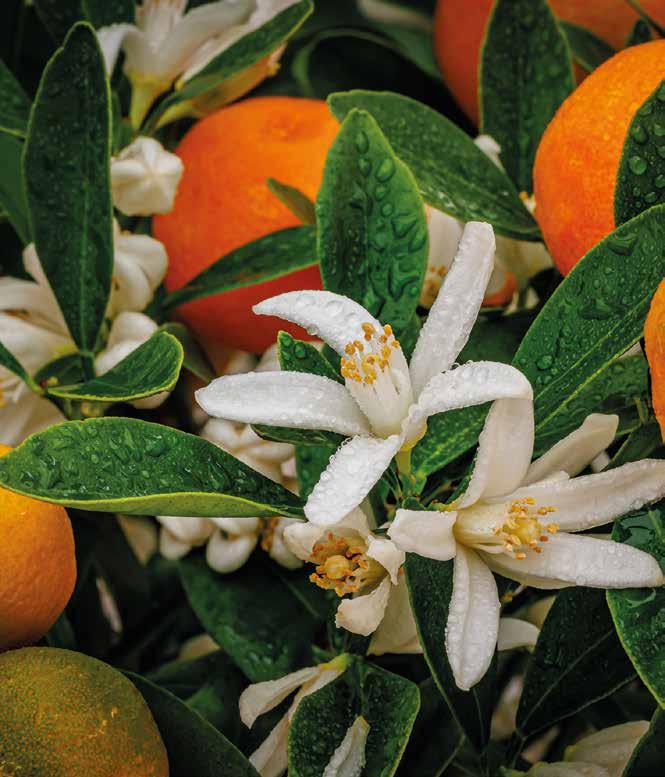
19
The citrus fruit season
YOU can

We understand the importance of trust in our business relationships, and we want to demonstrate that we are the trusted partners you are looking for to develop your fruit-based products. We are proud to present the 12 themes we have developed for 2024, which represent our commitments to you: sustainability, organic, innovation, expertise, quality, transparency, customer-focus, ethics, consistency, reliability, passion, customer trust.
We believe these commitments will enable us to further strengthen our partnership with you and continue to develop innovative and high-quality products together. We are committed to being transparent, sustainable, innovative, and adhering to the highest standards of quality and food safety, to provide you with excellent service that supports the success of your products.

us




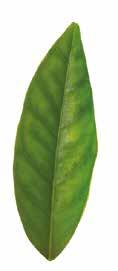
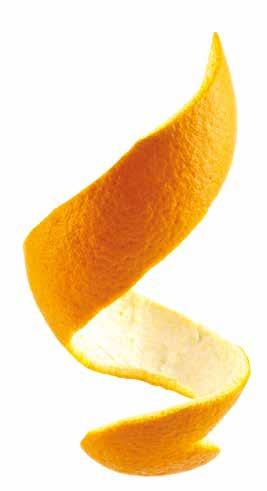


The phytosanitary conditions of citrus fruits
This section of the report relating to the citrus industry will focus on the assessment of the phytosanitary condition of citrus fruits. To carry out this analysis, we interviewed Dr. Agronomist Salvatore Lauria, owner of the technical office by the same name. Dr. Lauria is a consulting and planning expert in the
agricultural and agro-industrial sector. Furthermore, he is listed in the Reggio Calabria Court register of technical experts.
Dr. Lauria will lead us to explore in detail the phytosanitary condition of citrus fruits in Italy, providing a comprehensive informative overview.
1) Introduce yourself
My name is Salvatore Lauria, an experienced agronomist with a deep commitment to the development of Italian farms. My experience and expertise in
the agricultural sector, especially with regard to the phytosanitary condition of citrus fruits, allow me to provide an insight into the current state of citrus
2) What is the current state of citrus growing in Italy?
Currently, Italian citrus growing is increasingly oriented towards high quality production, including PGI, PDO and organic products: PGI Sicilian Blood Orange (Arancia Rossa di Sicilia IGP), PGI Calabrian Clementines (Clementine di Calabria IGP), PGI Clementines of the Gulf of Taranto (Clementine del Golfo di Taranto IGP), PGI Siracusa Lemon (Limone di Siracusa IGP),
Interdonato Lemon of Messina (Limone Interdonato di Messina), PGI Etna Lemon (Limone dell’Etna IGP), PGI Rocca Imperiale Lemons (Limoni di Rocca Imperiale IGP), PGI Gargano Oranges and Lemons (Arance e Limoni del Gargano IGP), PGI Amalfi Coast Lemon (Limone Costa D’Amalfi IGP), PGI Sorrento Lemon (Limone di Sorrento IGP), PDO Santa Maria del Cedro
3) What are the challenges for farms today?
Italian farms face significant challenges, including climate change and emerging diseases. Climate change involves temperature fluctuations and unpredictable weather patterns, affecting citrus production and quality. Emerging diseases require constant monitoring and management strategies. However, these challenges also
represent opportunities. Italian farms are adopting new citrus varieties that are appreciated by consumers, expanding their marketing calendar and implementing production and organisational models geared towards sustainability. These changes are essential for the sustainable growth of the Italian citrus sector. While there is a
groves. I sincerely thank you for this opportunity to share my observations and conclusions on this crucial topic.
Citron (Cedro di Santa Maria del Cedro DOP), PDO Reggio Calabria Bergamot (Bergamotto di Reggio Calabria DOP) and PDO Ribera Oranges (Arance di Ribera DOP). These productions are oriented towards sustainable and healthy locally-based practices, which are aspects increasingly demanded by modern consumers, who link food to their lifestyle.
worldwide increase in cultivated areas and international trade of citrus fruits, a radical restructuring of citrus farming is taking place in Italy. This renewal, driven by new varieties and cultivation practices, contributes to the development of a more resilient and future-oriented agricultural sector.
22 Citrus Report 2024
4) What changes are taking place?
Italian citrus growing is moving towards new varieties of citrus fruits that are appreciated by consumers, with a broadening of the commercial calendar and the implementation of new production and organisational models increasingly oriented towards sustainability. These elements are crucial to revitalise the sector. While there is a worldwide increase in cultivated areas and international trade of citrus fruits, a radical restructuring of citrus farming
5) What is the phytosanitary condition of citrus groves?
is taking place in Italy, oriented towards new varieties appreciated by consumers, with an extension of the marketing period and new production and organisational models increasingly focused on sustainability.
With regard to the phytosanitary condition, the complexity lies in the presence of citrus phytophagous insects, further complicated by the frequent introductions of exotic species. Therefore, it is essential to apply integrated pest management strategies providing for:
1. Preventive measures, including:
- Optimising the use of natural resources
- Limiting cultivation techniques with adverse impacts
- Strengthening of natural antagonists
2. Monitoring through decision-making tools
3. Control through the use of biological antagonists or plant protection products.
The main citrus phytophagous insects to monitor and control include the citrus thrips, Kelly’s thrips, woolly whiteflies, spiny whiteflies, brown aphids, green aphids, cucurbits aphids, white mealybugs, strong red mealybugs, citrus mealybugs, orange blossom moths, citrus serpentine miners, spider mites, citrus bud mites, broad mites and, of course, the fruit flies.
6) How do Italian farms address the issue of sustainability?
Italian farms are adopting water-saving initiatives and sustainable citrus disease control strategies. These measures include research into new products or techniques that have less impact on the environment, in order to promote sustainability in Italian citrus farming. The goals to be achieved by 2030 are ambitious but essential:
- Reduce pesticide use by 50%
- Reduce fertilisers use by 20%
- Reduce greenhouse gas emissions in the farming industry
- Increase the organic agriculture cultivated area to 25 % of the agricultural area used
Current innovation needs concern rootstock and varieties, irrigation management, phytosanitary management (including management of emerging diseases) and post-harvest. In particular, the use of different rootstocks and varieties can lead to achieve significant agronomic goals, especially if adopted sustainably, with the aim of providing the consumer with a high quality product over an extended period.

23 The phytosanitary conditions of citrus fruits
Telling about farms
Stories of passion and sustainability
An agricultural supply chain is not simply a set of numbers and challenges; it is the connective tissue of traditions, stories and values that give life to the Italian citrus sector. Every day, this supply chain winds its way through territories rich in stories, communities that work with passion and dedication, and companies that stand as custodians of a precious heritage. Citrus agriculture is more than just production; it embodies community development, care for natural spaces and the resources they offer. This symbolises our stories and the connections that make Italy a place of tradition and innovation. The vitality of citrus fruit agriculture emerges from the faces and stories of the people who dedicate their lives to cultivating and caring for these fruits, transforming them into excellences appreciated all over the world. This section tells about the commitment of extraordinary farms in Sicily and Calabria through their testimonies. These farms stand out for their heterogeneous size, with some boasting a cultivated area of 300 hectares, while others extend over 7 hectares. This varied landscape reflects the richness of the Italian fabric, characterised by an abundance of unique realities, each with its own distinctiveness.
Azienda Agricola Valleverde SRL is rooted in the Sicilian tradition, producing top quality oranges and lemons. With a history spanning decades of commitment and dedication, the company embodies the perseverance and evolution of organic farming, carrying on a legacy of passion and quality.
Azienda Agricola Surace stands out for its family passion for mandarins, oranges and lemons. Located in Calabria, precisely in Laureana di Borrello, the company does business since 2017 and has embarked on a path of renewal and transformation. The choice of new productive cultivars and advanced irrigation systems reflects the focus on sustainability and efficiency. The use of sensors for precision agriculture led to optimal use of resources, highlighting the commitment to modern and sustainable agriculture.
Azienda Agricola La Favorita S.S, with its commitment in the heart of Calabria, cultivates mandarins and bergamots, giving new life to a tradition that goes back decades. The company is the result of a passion handed down through generations, a bridge between the past and the future of Calabrian agriculture.
Azienda Agricola Franco Palumbo is an example of renewal and sustainability. Through the implementation of cutting-edge technologies, the company improves water and energy efficiency, demonstrating how innovation can coexist with deep-rooted tradition.
Azienda Agricola Mazzitelli, established in 1983 in Sicily, is the brainchild of the Gulino family. Focusing on oranges and lemons, the farm is located in the valuable areas of Lentini and Augusta. Organic farming is a central element, with prospects for expansion in this area. The history of the company is driven by the family’s dedication to agriculture, pointing to the future through organic farming and expanding production.
Azienda Agricola Merlino Antonino stands out for its commitment to the production of high quality citrus fruits through the use of sensors and precision farming techniques. The company exemplifies how innovation can improve the productivity and sustainability of agriculture.
Each company, with its own history and vision, contributes to a unique mosaic that defines Italian agriculture. Together, these farms embody the vitality and diversity that characterise citrus farming, reflecting a shared commitment to sustainability, innovation and continuous evolution. Through the challenges and opportunities presented by the sector, these companies exemplify how passion, tradition and sustainability intertwine to shape a brighter and more promising agricultural future.
24 Citrus Report 2024
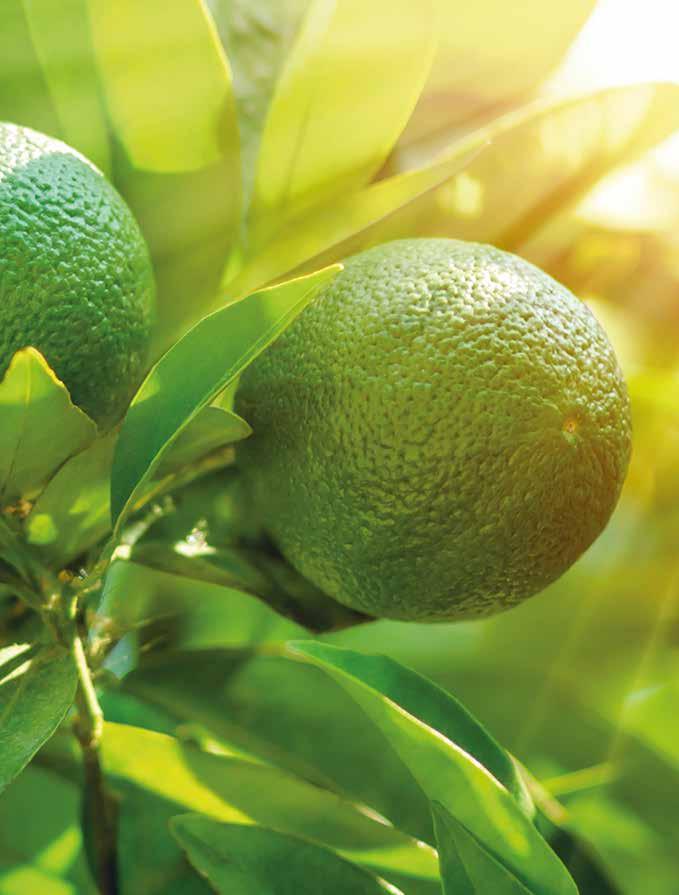
25 Telling about farms

Azienda Agricola VALLEVERDE
Via Federico di Svevia, 7 96016 - Lentini (Siracusa) Sicily
300 hectares
Description of the company
Company history
Citrus fruits produced
Protected origin citrus fruits produced
Certifications held by the company
Sustainability actions implemented
Future projects
Azienda Agricola Valleverde SRL represents excellence rooted in the beautiful Sicily. Through unparalleled attention to quality, we are passionately dedicated to the organic cultivation of oranges and lemons. Embedded in the farming areas of the province of Siracusa, precisely in Lentini and Augusta, we embody the essence of an environmentally friendly and constantly evolving agriculture. We look to the future with ambition, striving to expand our business and adopting sustainable solutions.
Established back in 1983, Azienda Agricola Valleverde SRL is the result of the ardent passion of the Gulino family. Our journey began with the goal of cultivating oranges and lemons of extraordinary quality. Our history intertwines with the lands of the province of Siracusa, an area we proudly embraced. The hills of Lentini and Augusta are the beating heart of our production, and what began as a dream has now become a concrete and respected reality.
• Oranges: 6.500.000 kg
• Lemons: 12.000.000 kg
PGI Siracusa Lemon (Limone di Siracusa IGP)
• GlobalG.A.P. (Good Agricultural Practices)
• IFS (International Featured Standards) Food
• BIOSUISSE
At the forefront of eco-sustainability, we adopted water and energy saving irrigation systems, preserving natural resources and reducing environmental impact.
We look forward with enthusiasm and ambition. We are planning expansion to increase our production and reach new markets. At the same time, we will invest in innovative technologies to meet the challenges of modern agriculture without ever losing sight of our commitment to the environment and quality.
26 Citrus Report 2024

Azienda Agricola LA FAVORITA
Description of the company
Via P. Umberto, 177 96011 - Augusta (Siracusa)
Sicily
100 hectares
We are experts in the cultivation of oranges and lemons. Our land extends across the valuable areas of the province of Siracusa, with particular reference to Lentini and Augusta, where we operate. We are engaged in organic farming and aim for a future of growth and development.
Company history
A fascinating story of passion and commitment guided us through the years. Experts in the cultivation of oranges and lemons, our roots lie in Siracusa, particularly in Lentini and Augusta, where our work comes to life. Our distinctive strength is the decisive choice for organic farming, which reflects our respect for the nature as well as for those who enjoy the fruits of our land.
Citrus fruits produced
Protected origin citrus fruits produced
Certifications held by the company
Sustainability actions implemented
Future projects
• Oranges: 4.500.000 kg
• Lemons: 2.000.000 kg
PGI Sicilian blood orange (Arancia rossa di Sicilia IGP)
• GlobalG.A.P. (Good Agricultural Practices)
• IFS (International Featured Standards)
We introduced high-tech drip irrigation systems that reduce water and energy consumption by up to 30% compared to conventional methods, demonstrating our commitment to environmental sustainability.
Our future plans include an expansion programme aimed at further strengthening our production and market presence, always in line with sustainable principles.
27
Telling about farms

Azienda Agricola MAZZITELLI
Via Argine Dx Annunziata, 13 89122 - Reggio Calabria Calabria
6.2 hectares
Description of the company
Azienda Agricola Mazzitelli is committed to the revival of the Mazzitelli family’s citrus tradition. Our passion is for the production of mandarins, clementines and bergamots in the province of Reggio Calabria.
Company history
Citrus fruits produced Certifications held by the company
Sustainability actions implemented
Future projects
Azienda Agricola Mazzitelli embodies a long-standing family tradition, a story rooted in a love for citrus fruits. Our mission is clear: restore and bring prestige to the Mazzitelli family’s citrus-growing tradition. Our inspiring passion pours into the production of citrus fruits of exceptional quality. Every tree we tend is a step forward in the rebirth of a tradition that has spanned generations, a deep connection to the earth and a promise of a bright future.
• Mandarins: 20.000 kg
• Bergamots: 14.000 kg
• Clementines: 25.000 kg
• ISO 9001 (Quality Management System)
We are committed to responsible water management and the use of organic fertiliser to promote environmental sustainability.
We look to the future with different ambitious plans, including strategies to protect fruit from heat waves, reducing tree spacing to optimise production, saving water and promoting pollination.
28 Citrus Report 2024

SURACE
Via Pietro Colletta, 19 89023. Laureana di Borrello Calabria
20 hectares
Description of the company
Azienda Agricola Surace is committed to the production of olive oil and citrus fruits, including oranges, mandarins and lemons. Established in the picturesque setting of Laureana di Borrello, we carry on a tradition of passion and dedication for farming.
Company history
Azienda Agricola Surace has deep roots: going from my grandfather’s generation through my father, now the third generation is proudly ready to run it. Our story is about an ongoing commitment to the art of agriculture, rooted in the past and looking to the future with enthusiasm.
Citrus fruits produced Certifications held by the company
Sustainability actions implemented
Future projects
• Oranges: 1.000.000 kg
• Mandarins: 50.000 kg
• Lemons: 50.000 kg
• SO 9001 (Quality Management System)
We show our commitment to sustainability by using rainwater collectors to irrigate our land, helping to reduce our impact on the environment.
We are looking ahead with ambitious plans, including new plantations that will allow to expand our production and continue to grow in the farming sector.
29
Telling about farms
Azienda Agricola

Azienda Agricola FRANCO
PALUMBO
Description of the company
Via Lurio, 13 89038 - Palizzi
Calabria
30 hectares
Azienda Agricola Franco Palumbo is a family-run citrus fruit farm.
Company history
With a history dating back 50 years, Azienda Agricola Franco Palumbo is firmly rooted in the citrus fruit sector. Founded with the aim of offering high quality citrus fruits to the markets, our company has grown and developed while maintaining its commitment and dedication.
Citrus fruits produced
Certifications held by the company
Sustainability actions implemented
Future projects
• Oranges: 100.000 kg
• Lemons: 50.000 kg
• Mandarins: 50.000
• Bergamots: 1.300.000
• Clementines: 50.000
• GlobalG.A.P. (Good Agricultural Practices)
• Organic Certification
• ISO 9001 (Quality Management System)
We work to reduce waste along the entire production chain, from water to soil, through the adoption of modern agricultural techniques.
We look to the future with the ambitious goal of completely transforming our agricultural land, concentrating our efforts on the production and valorisation of bergamot, the symbol of our land.
30 Citrus Report 2024

Azienda Agricola MERLINO ANTONINO
Contrada Barone, 2 89029 - Taurianova Calabria
7 hectares
Description of the company
Azienda Agricola Merlino Antonino is engaged in the cultivation and production of citrus fruits, with a particular focus on mandarins, oranges and lemons.
Company history
Citrus fruits produced
Established in 2017, the company embarked on a path of significant renovation and transformation. We enhanced the yield and profitability of the land through new citrus cultivars and highly efficient irrigation systems. The adoption of precision farming sensors is a step forward in the optimal management of our citrus groves.
• Oranges: 150.000 kg
• Lemons: 50.000 kg
• Mandarins: 100.000 kg
Certifications held by the company
Sustainability actions implemented
Future projects
• GlobalG.A.P. (Good Agricultural Practices)
We implemented micro-irrigation systems and use soil sensors to measure moisture, in order to optimise the use of water and energy resources.
We are working towards the installation of a photovoltaic system, a significant step in the direction of energy sustainability and reduced environmental impact.
31
Telling about farms
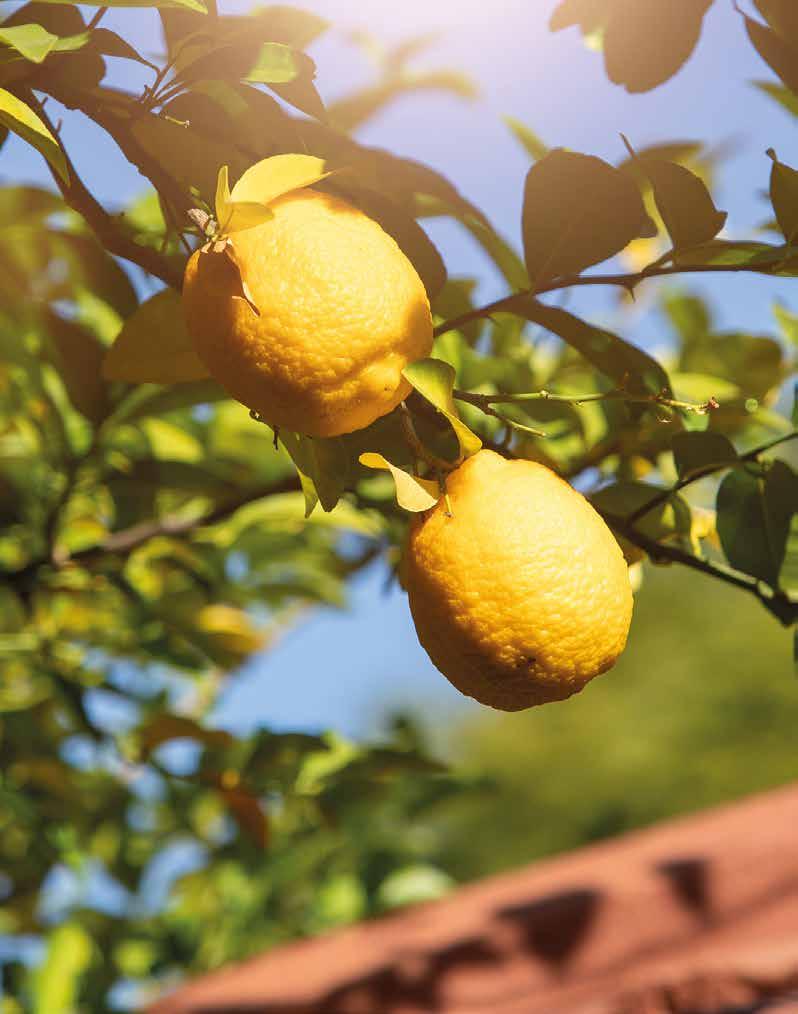
We are committed to minimizing the environmental impact of our activities. “
32 Citrus Report 2024
Agrumaria Reggina’s role In the next citrus season
Dear Partners,
Agrumaria Reggina is looking at its 39th citrus processing season, a journey dotted with growth, innovation and commitment to the citrus sector. This year, we want to continue to be one of the leading citrus processors in Italy, while maintaining our uniqueness in providing quality products in the fields of Nutrition and Cosmetics.
In the coming season, we aim to consolidate our role as a guarantor of stability and reliability in the supply chain for our customers worldwide. We are aware of the importance of a secure, reliable and constant supply for consumer product companies, and we are ready to play a key role in their value creation.
The significant increase in the share of processed organic citrus fruit is one of our initiatives to meet the growing consumer demand for organic products. Thanks to our partnerships with reliable producers, we decided to convert a substantial part of our volumes to organic cultivation, delivering to our customers more sustainable products in line with market trends.
We are aware of our responsibility towards the environment and the community in which we operate, and embarking on a sustainability journey allows us to closely monitor our impact on all stages of the citrus supply chain. We are committed to minimising the environmental impact of our operations and promoting sustainable practices both in terms of production and resource management.
In the coming season we will also significantly enhance our R&D potential. We are excited to inaugurate new laboratories dedicated to the Juice & Fruit and Essential Oil product units. These state-of-the-art laboratories will enable us to develop increasingly customised products with a high level of added value. Our continuous dedication to innovation will lead us to anticipate our customers’ needs and remain competitive in the global market.
Furthermore, thanks to the addition of a new 800 square metre department, equipped with a modern distiller and other state-of-the-art production technologies, we can meet the growing market demands and deliver to our customers a wide
range of high quality essential oils. Our commitment to constant research allows us to anticipate our customers’ needs and develop new and innovative products. We are ready to work with our partners and customers to make their supply systems more secure, reliable and consistent, ensuring them a stable and continuous supply of superior quality citrus fruits.
In conclusion, we are approaching a season full of challenges and opportunities, and Agrumaria
Reggina is ready to face them with passion and determination. We would like to thank our partners, customers and community for their support and trust, and we will strive to exceed expectations and maintain our position of excellence in the Italian and international citrus fruit sector.
“
We wish you a very bright and successful year.
Best regards, Sales and Marketing Director
33 Agrumaria Reggina’s role
About Agrumaria Reggina
Agrumaria Reggina is an Italian company specialising in fruitbased ingredients and solutions for Nutrition and Cosmetics consumer goods. For over 35 years, day after day, we have been dedicated to one goal: turning the best fruits into smart and effective ingredients and solutions.
We carefully follow each project from the first quality fruit processing
stage and operate an advanced supply chain that allows us to use the finest natural ingredients. Thanks to our R&D teams, we come up with unique and effective ideas and solutions, ensuring the highest quality of ingredients throughout the production process.
We deliver to our partners ingredients and solutions to help them become market leaders. We
provide market analysis, product development, production and product lifecycle analysis services. Our product portfolio is strategically diversified, encompassing categories such as concentrated and natural juices, essential oils, flavours and extracts, as well as all-in-one systems for beverages, yoghurt, milk products and more.
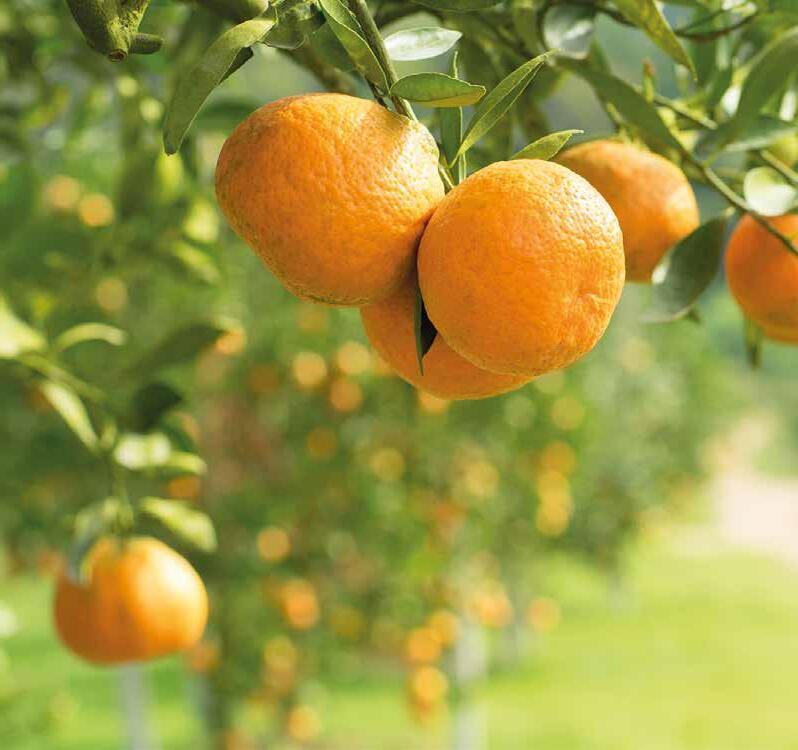
For further information, do not hesitate to contact us at info@agrumariareggina.it or visit our website agrumariareggina.it
Follow us on

Printed on recycled paper Discover more on agrumariareggina.it


































